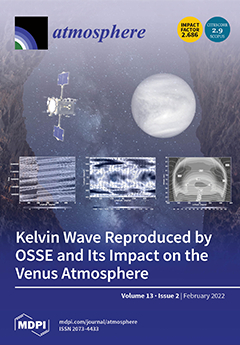The temporal and spatial distribution and variation characteristics of ozone (O
3) in Beijing, China, are investigated using hourly monitoring data from 2020. Kriging interpolation analysis and correlation analysis are applied to describe the spatial-temporal distribution and to identify associated influencing factors. The average concentration of O
3 was found to be 59.58 μg·m
−3. The daily maximum sliding 8 h average ozone concentration values exceeded the primary standard (100 μg·m
−3) for 129 days and exceeded the secondary standard (160 μg·m
−3) for 48 days. Temporally, the general pattern of daily maximum 8 h average O
3 concentration was high in spring and summer and low in autumn and winter. Monthly average values showed a maximum in June. The highest daily concentrations appeared between 13:00 and 18:00 local time, and O
3 concentrations had a distinct weekly pattern of variability with daily average concentrations at weekends higher than those during working days. Spatially, annual average O
3 concentrations were highest in the northeast and lowest in the southeast of the city, and the seasonal variation of O
3 was most significant in the southwest of the city. In relation to city districts and counties, the annual average O
3 concentrations in the Miyun District were the highest, while those in the Haidian District were the lowest. On the whole, annual average O
3 concentrations in Beijing were higher in the suburbs than in central areas. Based on daily average values, there was no significant correlation between O
3 concentrations and rainfall (
p > 0.05), but there were significant correlations between O
3 concentration and sunshine hours, wind speed, maximum temperature and minimum temperature (
p < 0.05), with correlation coefficients of 0.158, 0.267, 0.724 and 0.703, respectively. O
3 concentrations increased with an increasing number of sunshine hours, first increased and then decreased with increasing wind speed and increased with increasing temperature. O
3 concentrations were correlated with SO
2 concentrations (0.05 <
p > 0.001), CO concentrations (
p < 0.001) and NO
2 concentrations (
p < 0.001), the latter having the highest correlation coefficient of −0.553 and exhibiting opposite trends in daily and monthly variations to O
3 variations. Analysis of ozone pollution sources showed that automobile exhaust, coal and oil combustion and volatile organic compounds released by industrial plants were the main sources. Terrain affected the distribution of ozone, as well as human activities and industry.
Full article





